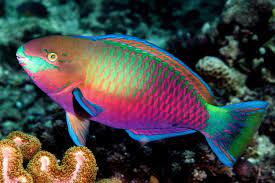
La inteligencia del delfín
General description.
Although we have all seen a dolphin at some point, whether on television, on the internet, in an aquarium or in the wild, we are going to describe a little about where they come from and why they are so intelligent.
Oceanic dolphins (Delpbinidae) are mammalian animals from a family of odontocete cetaceans that currently comprise almost 40 species.
They measure up to 8 meters long and have a fusiform body with a large head and an elongated snout. They have a single blowhole on the top of the head that they use to breathe. They have between 20 and 50 teeth in each jaw. In their heads they have the melon, a spherical organ that they use for echolocation, which we will talk about later.
Dolphins live in family groups of up to more than a thousand individuals in places with a lot of food. They have the ability to establish very close social ties, helping each other when an individual is injured or sick.

They reproduce face to face and their gestation periods vary depending on the species and can exceed 12 months. They only have one calf. Some scientists claim that they begin sexual activity before reaching sexual maturity. That is, they can copulate for pleasure and not only for reproductive instinct.
Being a mammal, they feed on breast milk during the first months. Next, their nutrition will be based on fish and squid as their main food.
They use several feeding techniques that we will describe in another blog.
As for their predation, they don’t have to worry much about being attacked. They are very fast and difficult to hunt. Only some species of shark attack them: bull shark, tiger shark, and white shark. Dolphin remains have also been found in the stomachs of orcas (which feed on almost any animal). But there is no evidence that it is due to feeding on dolphins, or trying to rescue them from shark attacks.
Why are dolphins so intelligent?
Dolphins have remarkable intelligence. Your brain is very complex. Dolphins have a notorious learning capacity and learn their routines very quickly. They are considered, along with chimpanzees, the most intelligent animals on Earth after man.

But, what is the reason for the dolphin’s intelligence?
Many dolphin brains are larger than human brains. But the intelligence of the dolphin is not solely determined by the size of its brain. Lori Marino, from Emory University in Atlanta, discovered through MRI that it has a cerebral cortex and neocortex so large that the anatomy that evaluates cognitive ability places it second after the human brain.
Additionally, Professor Diana Reiss of Hunter College of the City University of New York demonstrates that bottlenose dolphins can recognize themselves in mirrors and use them to inspect their bodies.
Another study claims that the dolphin’s intelligence is enough to learn a language based on symbols.
In Australia, a dolphin was rescued from its natural habitat and taught to walk on its tail during its three-week recovery in the aquarium. Once released, they saw that this technique was learned by other dolphins who were in the wild after having seen the released dolphin.
Scientists claim that they can be more intelligent than humans in certain aspects. Well, they are capable of adapting very well to the environment and taking advantage of various resources without altering the habitat that surrounds them.
Now, how do they communicate?

COMMUNICATION BETWEEN THEMSELVES
Vocal signals: They can be hisses, chirps, screams or pulsed sounds. They are capable of producing different whistles in different situations. For example, when they move away from the group, when they are happy or scared, when they feel in danger, or when they are locating their food. There are species such as the bottlenose dolphin, where each individual produces its characteristic whistle which they develop throughout their first year of life.
Non-vocal acoustic signals: Tail blows on the surface, fin blows both on the surface and on its own body, sounds of clenching its jaws, sounds of exhaling air, sounds of impacting its back with the surface of the water after jumping, sounds of produce streams of bubbles…
Visual signals: They can be body postures, gestures, synchronized swimming of one group to communicate with another group, jumps to show off…
Tactile signals: These signals are used as a sign of friendship. They join their bodies with other dolphins and rub each other. They also do it only by rubbing the fins.
COMMUNICATION WITH OTHER LIVING BEINGS
It is believed that they can communicate with humans and other animals.
In Laguna (Brazil), dolphins are able to communicate with fishermen by directing the fish to the nets and banging their tails and heads against the water to warn them that the nets are full.
Dolphins make sounds from their nasal cavities. In their blowhole there is a connective tissue that they are capable of vibrating at the frequency they wish to emit sounds. It is the same system that humans use to make sounds with our vocal cords. The sounds they are capable of generating are: Hisses, Screeches, Growls and Chirps. They use them to communicate with other cetaceans.

And echolocation; Is it a form of communication?
It may be believed as a form of communication between dolphins, but the reality is different.
Echolocation is a method to locate objects or individuals in their environment through the emission of high-frequency clicks or “clicks”. Dolphins do this with a structure called a melon located on their heads that is responsible for projecting and directing waves toward the front.
The waves emitted through the “clicks” bounce off the objects and return to the dolphins in the form of an echo. This allows them to know the distance at which the object to be identified is based on the return time of the echo. This system is useful in conditions of poor visibility.

Therefore, it is not a communication technique. They use it, for example, to locate prey or a predator.
Now you know a little more about dolphin communication…
Do you want to know more about echolocation?
Leave us in the comments what you think about the dolphin’s intelligence and the way they communicate and, above all, if you have any questions, do not hesitate to contact us.
We invite you to see other posts on our blog.
Good blue!!


